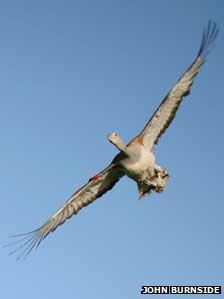Great bustards' droppings studied to aid conservation
- Published

Great bustards are the world's largest flying bird
Scientists are studying the droppings of great bustards with the aim of boosting their survival in a conservation project in the UK.
Great bustards, the world's largest flying bird, became extinct in the UK in 1832, but were introduced to Salisbury Plain in 2004.
The researchers have been examining the droppings of the released birds to monitor what they prefer eating.
They are also checking how the birds' diet changes through the year.
The LIFE+ Great Bustard Reintroduction Project is a partnership between the Great Bustard Group, RSPB, Natural England and the University of Bath, which has been working to establish a self-sustaining population of great bustards in southern England.
The reintroduction project has been regularly rearing chicks imported from Saratov, Russia, and releasing them once they are fully fledged at a secret location on Salisbury Plain.
This year for the first time they have also successfully hatched chicks from eggs brought over from Russia.
'Under a microscope'
"Relatively little is known about the diets of great bustards living in the UK," said Scott Gooch, from the University of Bath LIFE+ project monitoring team.
"Watching bustards in the wild can give you information on where they prefer to feed and how much of their time they devote to feeding.
"But by examining their droppings under a microscope we can discover the quantities of different insects and plants in their diet and how this changes across the year."
Understanding what the birds eat in the wild will help the development of targeted habitat management for great bustards in the UK.
"The success of this reintroduction project depends on whether there is enough food to support great bustards through the autumn and winter," said fellow researcher Dr Kate Ashbrook.
"We believe there is, but it is important to monitor their diet so we can ensure there is sufficient suitable habitat for them as the population grows."
- Published12 July 2012
- Published10 June 2010